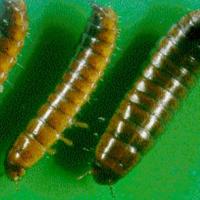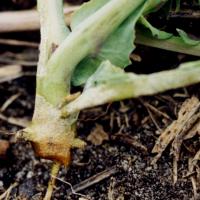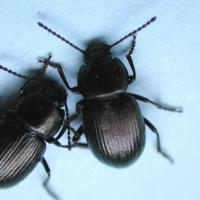Diagnosing false wireworm
False wireworms that damage canola crops are the larval stage of the bronzed field beetle. Vegetable beetle larvae are also called false wireworms but breed in summer so their larvae rarely damage winter crops.
What to look for
- Patches or areas of dead, ringbarked or weak seedlings that often coincide with heavier stubble residue especially lupins.
Paddock
- Seedlings that are weak or dying as they emerge, with chewed roots and stems.
- Fallen plants that have been ringbarked.
Plant
- Adult bronzed field beetles are shiny black to bronze in colour or dark grey to black in colour (vegetable beetle). Both are about 10mm long.
- They feed on decaying organic matter and can rarely be found feeding on damaged leaves.
Insect Adult
- Dark brown worm-like grubs up to 12mm long with shiny hard skin and upturned spines on the end of the body.
Insect Larvae
What else could it be
| Condition | Similarities | Differences |
|---|---|---|
| Diagnosing blackleg in canola | Sudden seedling death | Blackleg lesions on plants. Lack of insects or chewing damage |
Where did it come from?
- False wireworm are native insects that usually eat decaying organic matter.
- Over the summer and autumn, adults shelter in crop residue, stumps or tufts of grass. They do not fly but become active after autumn rains when a large proportion of a female's body may be taken up with eggs. When there is early moisture, these larvae may reach a length of five millimetres or more before the crop is seeded. In August larvae begin changing to the pupal stage and new adults appear soon after.
- Stubble retention practices favour this pest as crop as dense crop or pasture residues on the soil surface benefit their survival and breeding. Lupin stubble appears to be particularly suitable.
Management strategies
- Sprays and seed dressings are ineffective against bronzed field beetle larve.
- Reseeding with higher seeding rates may be an option in bare areas.
- The removal of much of the surface plant material, where it is considered to be a suitable practice, will reduce or eliminate this pest. This may be achieved through cutting and baling, grazing or burning.
Economic and financial considerations
To assist in assessing the economic risk and financial costs associated with various treatment strategies go to MyEconomicTool
There may be other economic and financial implications that need to be considered when choosing a management option. These may include:
Pre-crop- Understand the potential yield losses associated with false wireworm feeding damage.
- Assess the cost and benefits of removing surface plant material prior to seeding.
- Compare the costs, benefits and risk of each management option against doing nothing or delaying treatment.
- Ignore all previous treatment costs when assessing current management options.
- Include a resistance management strategy into your spray program.
View these economic considerations in more detail.
How can it be monitored?
- 15 adults per square metre in summer may produce over 1500 larvae, which is enough to damage most canola crops at the seedling stage.
See also
Page last updated: Monday, 1 May 2017 - 11:56am





